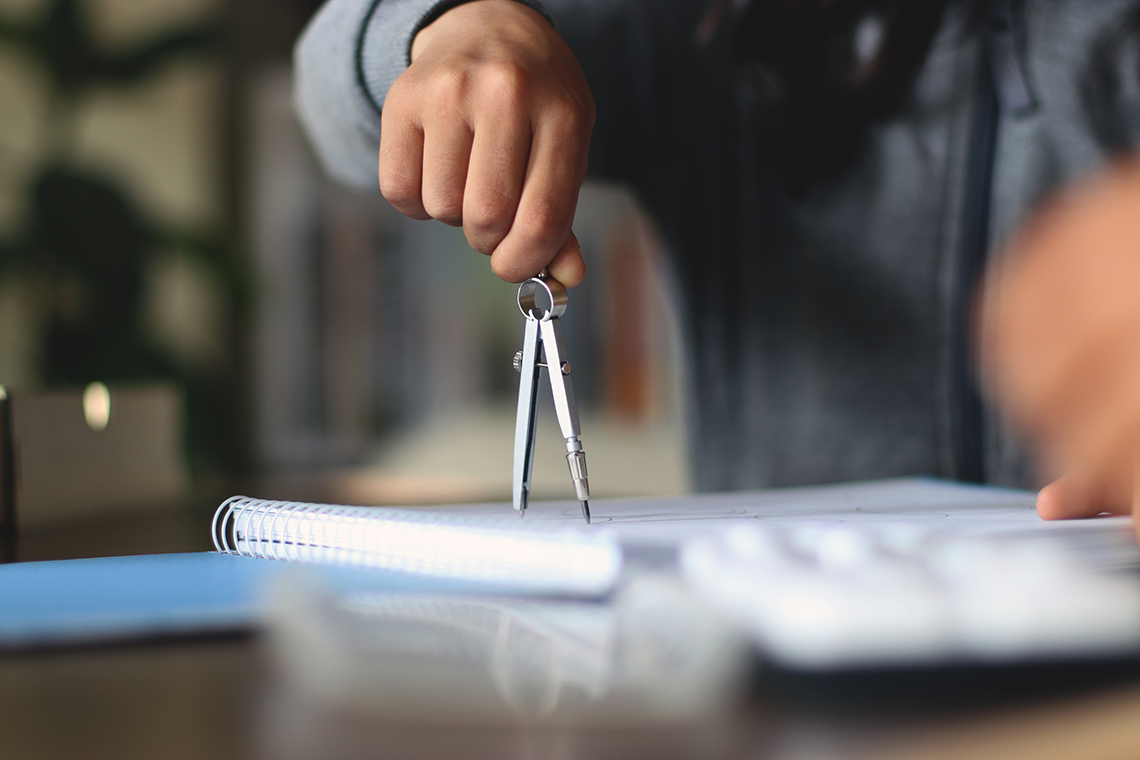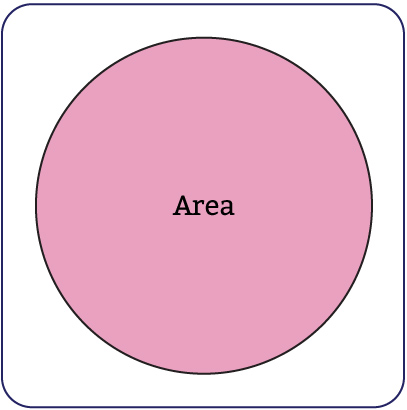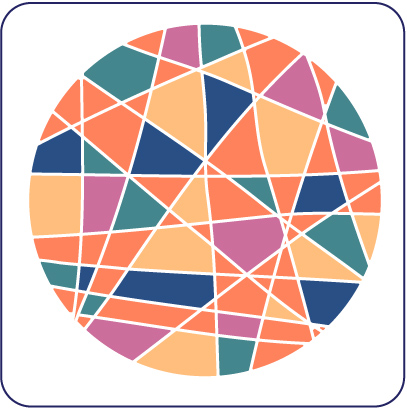Minds On
Parts of a circle

For each term, select the corresponding definition.
Press 'Let's check!' to reveal parts of a circle.

This is a diagram illustrating the circumference, diameter, and radius of a circle.
The circumference is represented by the capital letter “C.” The circumference is the distance around the outside edge of a circle. This is an identical concept to calculating the perimeter of a polygon. On the diagram, the circumference is the arrow that goes around the entire circle.
The diameter is represented by the lowercase letter “d.” The diameter is the distance across the circle, that goes through the centre of the circle. On the diagram, the diameter is the arrow that goes from one end of the circle to the other.
The radius is represented by the lowercase letter “r.” The radius is the distance halfway across the circle, which is equal to half of the diameter’s length. To calculate the radius, you can divide the diameter by 2. On the diagram, the radius is the arrow that starts from the centre of the circle and crosses to a point in the circle.
Explore
Let's explore this video entitled "Area of a Circle Formula" to learn more about the area of a circle.
Action
Understanding circumference of a circle
The circumference of a circle is the distance around the outside edge of a circle.
This concept is identical to the concept of calculating the perimeter of a polygon.
However, since a circle has no sides, we need to think a little differently about how to calculate its circumference.
One strategy which can be used to find the circumference is by using string to explore the circumference of the shape. To find the circumference, we can wrap a string around the circle.
Measuring
A piece of string is an example of something that can be used to help measure length.
Let's explore the following steps to measure the circumference of a circular object:
Step 1
To begin, we can use a length of string or another method of measurement to wrap around a circular object. This might be a bowl, a trash can, a coffee cup, a basketball hoop, or any circular object around you.

After measuring the object, take that piece of string and cut it or mark the measurement. Note that you are now working with a piece of string that is equal to the circumference of your object.
Step 2
Next, use the same piece of string to measure the diameter of the circular object. Start from one spot on the edge of the circle to a spot on the opposite side (trying to go through the centre). Now, cut or mark that piece.

Let's use what's left of your string to measure the diameter again. Cut or mark that measurement. Continue to do this until the string is too short to measure the diameter.
Step 3
In the end, the piece of string that was the measure of the circumference should be cut into 3 equal pieces, and a shorter piece. That little piece of string that was left over, should be just over one tenth of the other pieces.

These steps can be compared to actual calculations.
Take the circumference of a circle and divide it by the diameter, you will always end up with 3.14 or π.
No matter the circle, the value of the circumference to diameter will be approximately 3.14.
This can also be represented as:
Circumference ÷ Diameter = approximately 3.14
3.14 is the value of pi or π.
So, if Circumference ÷ Diameter = approximately 3.14, we can deduce a formula for the circumference as:
Circumference = π × Diameter
or
Circumference = πd
Student Tips
Did you know?
Recall that the diameter is double the radius for any circle.
So, we can write d = 2 × r or d = 2r
Circumference = πd, which is the same as Circumference = π × 2r
or
Circumference of a circle = 2πr
Calculating the circumference
Now that you understand the relationship between circumference and diameter and have explored the formula for calculating the circumference of a circle, let's apply the formula!
If you would like, you can complete the next series of calculations using TVO Mathify or a method of your choice. You can also use your notebook or the following fillable and printable document.

Press the ‘TVO Mathify' button to access this interactive whiteboard and the ‘Activity’ button for your note-taking document. You will need a TVO Mathify login to access this resource.
TVO Mathify (Opens in a new window) Activity (Open PDF in a new window)Press 'Let's check!' to reveal the calculations for the activity Calculating the Circumference.
Check out the calculations for the Calculating the Circumference activity:
1. With
2. With
3. With
4. With
To find the radius, we can divide the diameter by 2:
Area of a circle
Student Tips
The formula
To calculate the area of a circle, we use the following formula:
- "A" represents the area
- "r" represents the radius
Part 1: Exploring the formula
If you would like, you can complete the next series of word problems using TVO Mathify or a method of your choice. You can also use your notebook or the following fillable and printable document.

Press the ‘TVO Mathify' button to access this interactive whiteboard and the ‘Activity’ button for your note-taking document. You will need a TVO Mathify login to access this resource.
TVO Mathify (Opens in a new window) Activity (Open PDF in a new window)Press 'Let's check!' to reveal the calculations for the activity Exploring the Area of a Circle.
|
Question 1 |
The amount of cardboard the restaurant will need is 153.9 cm² |
|
Question 2 |
The amount of pool cover material we will need is 113.1 m² |
Part 2: Calculate using the formula
Now that we have explored how the formula for the area of a circle is derived, let's apply it to word problems.
If you would like, you can complete the next series of word problems using TVO Mathify or a method of your choice. You can also use your notebook or the following fillable and printable document.

Press the ‘TVO Mathify' button to access this interactive whiteboard and the ‘Activity’ button for your note-taking document. You will need a TVO Mathify login to access this resource.
TVO Mathify (Opens in a new window) Activity (Open PDF in a new window)Press 'Let's check!' to reveal the calculations for the activity Calculating the Area of a Circle.
| Question 1 |
The area of the circle is 314 m² |
| Question 2 |
The area of the circle is 84.95 km² |
Part 3: Calculate the radius and diameter
The formula
is often used to find the area of a circle when you know the radius. But, what if you know the area and need to find the radius?
Step 1
Let's say we have a circle with an area of 28.28 cm ². First, replace the A with the area total of 28.28:
Step 2
Then, divide both sides by to isolate for :
Step 3
Now, to find the value of , let’s take the square root of 9.002:
This means that a circle with an area of 28.28 cm² has a radius of 3.0 centimeters.
If you would like, you can complete the next activity using TVO Mathify or a method of your choice. You can also use your notebook or the following fillable and printable document.
Press the ‘TVO Mathify' button to access this interactive whiteboard and the ‘Activity’ button for your note-taking document. You will need a TVO Mathify login to access this resource.
TVO Mathify (Opens in a new window) Activity (Open PDF in a new window)Press 'Let's check!' to reveal the calculations for the activity Calculating the Radius and Diameter.
|
Question 1 |
The radius of this circle is 2.1 cm. |
|
Question 2 |
The diameter of this circle is 4.5 m. |
Consolidation
Mosaics
Let's examine the following circular mosaic, which is like a sunflower on a wall.

As we learnt about calculating circumference and the area of a circle, you may wonder:
- How many small square tiles are lining the circumference of this circle mosaic?
- How many small square tiles did it take to fill this circle mosaic?
Counting the tiles is one option, but using calculations simplifies the process.
Describe how you would find out the answers to your questions and apply any of the formulas from this lesson to help you.
If you would like, you can complete this activity using TVO Mathify. You can also use your notebook or the following fillable and printable document.

Press the ‘TVO Mathify' button to access this interactive whiteboard and the ‘Activity’ button for your note-taking document. You will need a TVO Mathify login to access this resource.
TVO Mathify (Opens in a new window) Activity (Open PDF in a new window)Reflection
As you read the following descriptions, select the one that best describes your current understanding of the learning in this activity. Press the corresponding button once you have made your choice.
I feel...
Now, expand on your ideas by recording your thoughts using a voice recorder, speech-to-text, or writing tool.
When you review your notes on this learning activity later, reflect on whether you would select a different description based on your further review of the material in this learning activity.
Press 'Discover More' to extend your skills.
Discover MoreMaking connections
If you would like, you can complete the next activity using TVO Mathify or a method of your choice. You can also use your notebook or the following fillable and printable document.
- What is the relationship between the circumference of a circle and π ?
- Create a real-world context question involving either circumference or area of a circle and answer your question.
- What connections can you make from your life to your new learning?
Press the ‘TVO Mathify' button to access this interactive whiteboard and the ‘Activity’ button for your note-taking document. You will need a TVO Mathify login to access this resource.
TVO Mathify (Opens in a new window) Activity (Open PDF in a new window)Connect with a TVO Mathify tutor
Think of TVO Mathify as your own personalized math coach, here to support your learning at home. Press ‘TVO Mathify’ to connect with an Ontario Certified Teacher math tutor of your choice. You will need a TVO Mathify login to access this resource.
TVO Mathify (Opens in a new window)